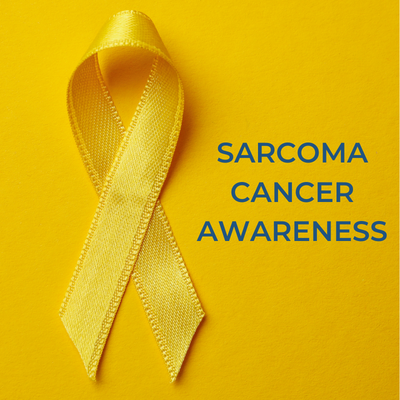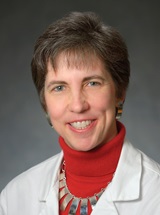This blog shares some ways to tell if a new or existing lump could be a sarcoma and, if so, what steps you should take next. If you are not sure, see your primary care provider.
What is Sarcoma?

A sarcoma is a type of cancer that forms in bone or soft tissues like muscle, nerves, fat, fibrous tissues, tendons, or blood vessels. Sarcomas can grow anywhere in the body. Soft tissue sarcomas most often show up as a lump or bump on the arms or legs. Bone sarcomas can be harder to detect.
Sarcoma is a very rare but serious disease. The American Cancer Society states there are about 13,400 new cases of soft tissue sarcomas will be diagnosed in the United States each year. In comparison, over 295,000 cases of breast cancer and more than 288,000 cases of prostate cancer are diagnosed each year.
Signs and Symptoms of Sarcoma
Early detection is key to finding and treating sarcoma successfully. There are four things that can help you figure out if a new or existing lump could be a sarcoma.
1. Where It Is
Most sarcomas are found in the arms and legs – often at the upper end of a limb. They can also be found in the buttocks, chest wall, pelvis, and head and neck areas.
“Sarcomas can grow to be big, deep masses in the upper part of the extremity, just below the buttocks, in the thigh, or in the upper arm,” says Kristy L. Weber, MD, Director of the Penn Medicine Sarcoma Program at the Abramson Cancer Center.

Dr. Weber notes that while you shouldn’t ignore a lump in the fingers or feet, less than one percent of bumps found in the fingers or feet turn out to be sarcoma. Fingers and feet are common sites of cysts or other benign (noncancerous) soft tissue lumps. One of the most common soft tissue masses in the hands and feet is lipoma, which is a slow-growing, benign fatty lump. Often, a lipoma feels doughy, is not tender (sore), and can move around when pressed.
2. How Fast it Grows
If your lump has grown, especially quickly, Dr. Weber recommends seeing your healthcare provider to look at it. And anything that’s grown to the size of a golf ball needs to be looked at by a provider right away.
On the other hand, if it’s remained about the same size over a few weeks to months, it’s most likely not a sarcoma. You should still see your healthcare provider to have it checked. Depending on the size and where it is, your provider may order an MRI or ultrasound.
3. Pain
Many soft tissue sarcomas do not cause pain, which leads people to think they don’t need to get it checked out.
When a sarcoma is deep, growing quickly, and found near sensitive areas like the sciatic nerve, it may cause pain. A sarcoma that starts in a bone causes pain and other symptoms.
4. Firmness
Firmness could also be a sign that your lump is more than a fatty deposit like a lipoma. If your lump is soft and easy to move around, it is less likely to be a sarcoma, but Dr. Weber recommends keeping an eye on it just to be sure.
What To Do If You Think You Might Have Sarcoma
These four things are meant to help you learn if a lump or bump could be a sarcoma, but it’s important not to put too much weight on any one of them. If you believe that your lump needs a closer look by a provider, they’ll use these when looking at your lump.
Start with your primary care provider. They’ll do a physical exam and take a thorough look at your medical history. They will decide whether to order tests such as an MRI or ultrasound of your lump.
If the imaging shows the lump to not be cancer, Dr. Weber says it can be watched over time.
If the imaging suspects cancer or the results are inconclusive (unsure), your next appointment should be with a specialist like Dr. Weber. They’ll review your imaging and history and do their own exam to decide whether your lump should be watched over time or biopsied.
Expertise Is Critical
Because sarcoma is so rare, diagnosing and treating it requires a deep knowledge of the disease. Over the years, Dr. Weber has cared for a number of patients who had lumps removed by surgeons who did not specialize in sarcomas. Sometimes surgery was done without any prior imaging or a needle biopsy.
Removing a sarcoma without taking a wide margin (piece) of normal tissue around the tumor means that cancerous cells are likely left in the surgical area. In this situation, a second surgery, usually along with radiation, is needed to be sure all the tumor cells are removed.
“The bottom line is, you want to get a sarcoma removed correctly the first time, by an expert who specializes in sarcoma care,” Dr. Weber says. Because it is hard to diagnose, the expertise of your sarcoma care team should extend beyond the surgeon, she says.
“In general, for radiologists and pathologists that don’t see sarcomas all the time, the risk of making a mistake is higher because they aren’t seeing them every day,” Dr. Weber says. “The key thing is, we want to make sure it is a sarcoma. Deciding whether it is or isn’t is critical. And unless you’re a radiologist or pathologist that does this a lot, differentiating a benign tumor from a malignant one can be hard.”
There are more than 50 different types of soft tissue sarcoma, making the diagnosis even harder.
Treating Sarcoma
Treatment for sarcoma depends on the type, stage, and where the tumor is found. At a sarcoma specialty center, your team will consider your specific needs and create a custom treatment plan built with your cancer and lifestyle in mind. Your team will include many specialists – this is often called a multidisciplinary team. The team may include a sarcoma surgeon, plastic surgeon, medical oncologist, radiation oncologist, physical and occupational therapists, registered dietitians, nurses, social workers, and more. In general, sarcoma treatment almost always involves surgery and may involve chemotherapy and/or radiation therapy as well.
Dr. Weber’s team at the Abramson Cancer Center is one of the top centers devoted to diagnosing and treating both soft tissue and bone sarcomas. It is a multidisciplinary team comprised of nationally recognized experts with years of sarcoma experience.
The goal of sarcoma surgery and care, overall, is to remove the tumor while maintaining as much function and quality of life as possible. This is something that Dr. Weber’s team keeps top of mind for every patient they treat.
Resources for more information
- Sarcoma information on Oncolink.
- The Sarcoma Alliance website.
- Sarcoma Foundation of America website.
About the author: Kristy L. Weber, MD currently serves as Director of the Sarcoma Program in the Abramson Cancer Center. She specializes in treating children and adults with benign and malignant bone and soft tissue tumors as well as metastatic bone disease. Limb salvage surgery around the shoulder, hip, knee, and pelvis is of particular interest. Dr. Weber has built a collaborative sarcoma research team combining clinical and basic research between Penn Medicine and Children’s Hospital of Philadelphia. Dr. Weber was elected to the Penn Academy of Master Clinicians in 2017. She recently served as President of the American Academy of Orthopaedic Surgeons (AAOS) in 2019-2020 and is the Academy’s first woman president.
If you would like to make an appointment with Dr. Webber’s team, call 800-789-7366 (PENN) or fill out their online contact form. The Penn Sarcoma Program offers same-day appointments to patients who have their imaging available. To learn more, call 215-349-8200.